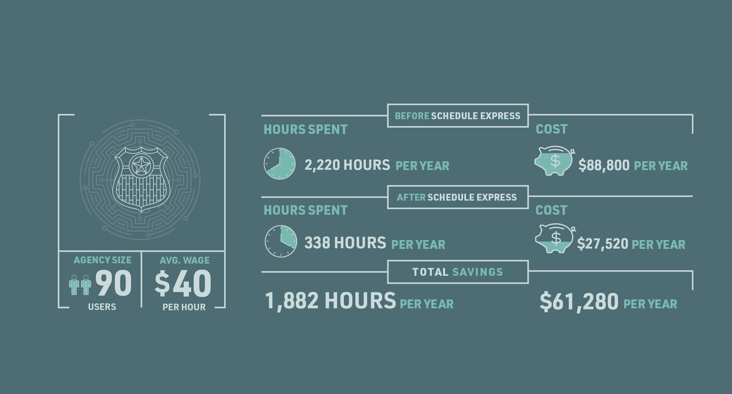Reducing budget impact and reclaiming time with automated scheduling
Although more public safety agencies are adopting software solutions to support their operations, many agencies continue to use manual methods for their scheduling such as pen and paper, Excel spreadsheets, Word documents, and more. While some scheduling programs do some of these things, many are not built for public safety environments, which often means they’re not comprehensive solutions. Unfortunately, in addition to being time consuming and expensive, the processes are also often error-prone – both the initial creation, as well as the ongoing management of the ever-changing scheduling document. These efforts include the need to build a schedule from scratch, determine which shifts happen on which days and who will fill them, coverage management, the processing of absence and trade requests, overtime management, manage shift and vacation bidding, and much more. And – hopefully – taking employee preferences into account.
Scheduling is a necessary and important process for all first responders, but it is far from the most important part of their job. When you break down the time, and the cost of that time – especially for supervisors – the right scheduling software is an exceptionally high-impact solution which can make a significantly positive difference for management and employees alike.
Assessing the value of investing in the right scheduling solution
Every agency will have different results depending on their current operations and the software solution they choose to implement. Below is one example scenario, and the next section includes steps to calculate these same numbers for yourself.
One law enforcement agency of 90 sworn and unsworn employees who switched from a less functional scheduling program to Schedule Express, an automated scheduling solution built specifically for public safety, did a deep-dive into their finances to gain a precise understanding of the impact from migrating to a system that served their needs effectively:
- They found their total time savings was 1,882 hours on an annual basis, year after year, after reducing their time spent scheduling from almost 43 hours per week to 6.5 hours per week.
- Accounting for their average wage of $40/hour of all those involved with scheduling, as well as the cost of the new program, they calculated a net savings of more than $61,000 annually. And, not just one year – but every year they continue this process.
- It also meant gaining nearly one additional full-time employee using the headcount already put into place, and the ability to reclaim those 36 hours per week for more important agency tasks than scheduling.

In addition to the time they were able to reclaim, the positive impact to their budget was significant. Further, improved accuracy and audit trails provided even more organizational benefits. Scheduling solutions built for public safety and designed to meet agency needs will be configured on the back-end to automate unique rules, regulations, policies, and procedures to ensure all activities are compliant and auditable. This converts tedious, manual tasks into effortless automatic workflows intelligently driven by your custom-built ecosystem, which eliminates the human margin of error and gives more control to the organization.
How to calculate the value to your unique agency
While the above scenario is a very typical example of potential savings, ultimately the final result of upgrading your scheduling solution will be unique to your agency, so the best approach to make a decision is to assess the anticipated value for yourself:
- Add up the current time spent on scheduling tasks per week.
Consider overtime management, processing absences (vacation, sick leave, etc.), and any additional tasks such as data entry, training, trades, reports, and more. Don’t forget events that may happen less regularly, such as the initial building of schedules and rotations to factor into your averages.
In the example above, their average time spent before implementing Schedule Express was about 42.7 hours per week, which is how they calculated an annual total of 2,220 hours spent on scheduling. - Then, multiply the total number of hours by the average wage of the supervisory employees executing those tasks.
In this way, you’ll gain a fairly good idea of how much money is truly being spent on manual processes – even if they seem free. This is your baseline to compare solutions against when it comes to calculating the value of your potential savings.
In the example above, the average wage was about $40/hour, which multiplied by their total annual hours, brought their total annual spending to approximately $88,800. - Consider the cost of a software solution.
The number you learned above can be taken to decision-makers, which they can then weigh against the cost of implementing a scheduling software in order to demonstrate the total cost savings and reduction to budget.
In the example above, the cost was around $14,000 per year for Schedule Express. - Estimate your ROI with all solutions being evaluated.
Request case studies from vendors to get an idea of who they serve and what their results have been. Consider the size of your agency, and any other similarities to existing clients in order to find the closest match.
Schedule Express delivers an average financial savings of 70.2% based on annual cost of labor. In the example above, this is the number they would use to estimate potential savings. Don’t forget to consider the hours themselves as well, which in this scenario is an average of 87% based on annual hours. - Find your total savings.
This will be the cost of the annual hours saved by your new solution, and then subtracted by the cost of that solution. This will give you the final number of what your agency is saving annually, and will continue to save each year you use your new scheduling process.
In the example above, Schedule Express took their annual hours spent on scheduling tasks from 2,220 to only 338. This is how they calculated their 1,882 hours of annual time savings. Multiplied by $40/hour, their total is $75,280. Finally, subtracted by the $14,000 cost of the software, they now know making the switch saves them $61,280 every year. - Account for the impact of your reclaimed hours, too.
More than just the dollars saved, reclaiming those hours means they will become available again for agency use, which can result in effectively gaining additional headcount. For example, saving 40 hours per week previously spent on manual scheduling tasks is the equivalent of hiring one new full-time employee.
In the example above, their 1,882 hours per year means 36 hours per week gained back for the organization, which is nearly one additional full-time employee without needing to hire.
Each individual component of scheduling automation is just one piece of the puzzle, so it’s important to look at your operations as a whole when making a decision. In almost all cases, the more into your processes you dig, the more return on investment you will find that you’ll receive from an automated scheduling software. For many agencies, there are budgetary concerns regarding the cost of purchasing and implementing a new solution. It’s an important consideration, but through the above exercise you can get a big-picture estimate on what your agency stands to gain.
Benefits to the employees
System automation means much less hands-on work for anyone at the agency, including schedulers and supervisors. With Schedule Express in particular, because your agency’s unique needs are configured by the SafeCities™ team directly into your scheduling environment, you can ensure compliance for all scheduling activities, including trades, bidding processes, absence requests, overtime management, and more. Because the process for management to approve or deny requests is simplified and auditable, it provides employees much more flexibility and freedom to take control of their schedule.
For example, if an employee makes a request which violates a rule, such as one that will result in a coverage shortage, supervisors will receive a warning before being presented the option to approve or deny the request. If the supervisor chooses to approve, it will make intelligent suggestions, such as candidates for mandated overtime, or allowing all qualified and available volunteers to be notified at once via text message, email, and mobile app. The program will then enforce your agency’s rules, such as sorting lists by seniority, hours worked, rotation, or first-come-first-serve volunteers. Because it takes the work – and the guesswork – out of action required from the scheduler, it results in a more agile schedule that can be more empowering for the employee.
How to purchase an automated solution
Purchase direct
The most straightforward approach is reaching out directly to vendors such as SafeCities™ for demonstrations and quotes.
Government contracts
To bypass bureaucratic processes, such as an RFP, government contracts may be a faster way for your agency to access a solution which is already approved for use. These can allow you to efficiently procure a service.
Schedule Express is available through:
- NPPGov, a national organization that offers publicly solicited contracts to government entities nationwide.
- The California Department of General Services Software Licensing Program.
Check to see if your agency leverages these contracts, and you may find the process significantly simplified.
Access federal funds
In March 2021, the Federal Government made new funds available for local public safety agencies – law, 911, fire, and more – across the country through the American Rescue Plan (ARP) Act. The article linked below details how to apply for and receive new federal funds in order to purchase cutting-edge products and services, such as Schedule Express — with no impact to your budget.
Use another public safety agency’s RFP
It’s also possible to leverage another agency’s RFP process to find a software solution that works for your agency as well. They may have different requirements or desires than your agency, so make sure the system you want has everything your agency needs to support its unique operations. That said, it can still be an excellent place to start to learn from their research.
With the right system installed and integrated, public safety agencies will find themselves able and empowered to reduce labor costs, curb absenteeism, and above all: support their employees - the first responders who serve our communities.





Submit a Comment